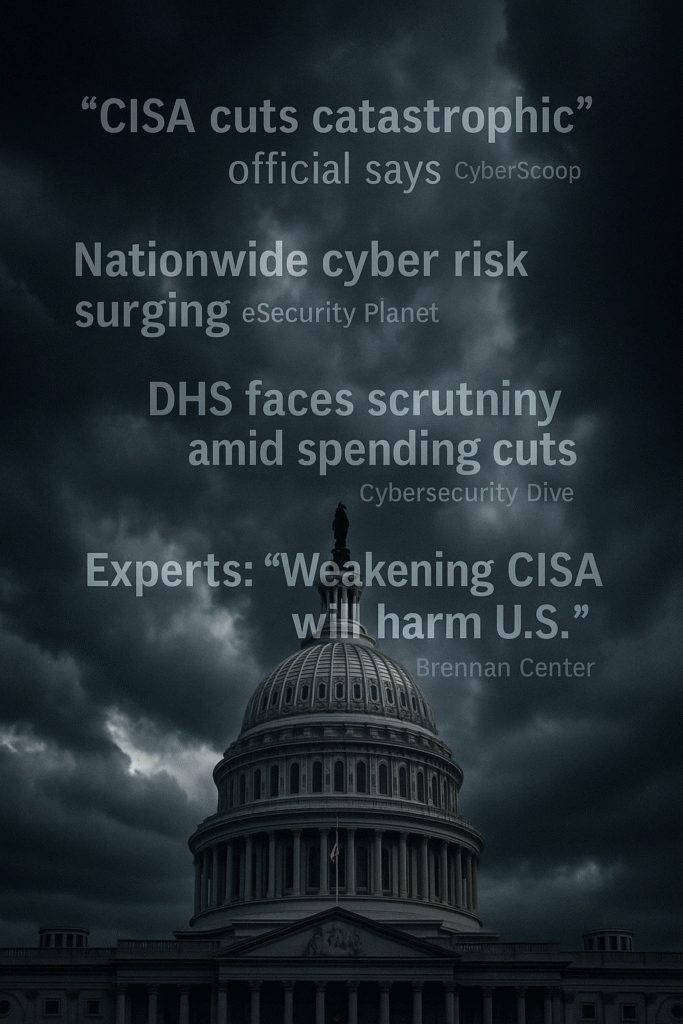
What happens when the very agency tasked with protecting America’s digital infrastructure is gutted from within? In 2025, the Cybersecurity and Infrastructure Security Agency (CISA) is facing an unprecedented crisis. Proposed CISA budget cuts could eliminate nearly 1,300 positions—almost 40% of its workforce—including mission-critical roles across election security, infrastructure defense, and cyber threat analysis.
This is happening at the worst possible time. Nation-state cyberattacks from Russia, China, and North Korea are increasing in frequency and sophistication. Our digital infrastructure is more interconnected than ever. And the systems we rely on to power cities, count votes, and safeguard national secrets now face a future with significantly fewer protectors.
Trump administration directives are driving a wave of buyouts, early retirements, and forced layoffs at CISA. These aren’t just internal shakeups—they’re dismantling a national cyber defense strategy years in the making. This blog explores six critical consequences of these CISA budget cuts, examining what they mean for the future of U.S. cybersecurity, and what must be done to prevent disaster.
The Looming Cybersecurity Crisis: Understanding Proposed CISA Budget Cuts

Scope of the proposed budget reductions and workforce layoffs
The proposed CISA budget cuts could slash nearly 40% of the agency’s personnel, eliminating up to 1,300 jobs. These include top analysts, threat intelligence officers, and outreach coordinators in key divisions such as the National Risk Management Center and the Stakeholder Engagement Division (CISA Faces Massive Cuts, eSecurity Planet).
Programs and departments already impacted
CISA Layoffs have already hit CISA’s backend operations and essential staffing in analysis and coordination centers. Programs like CVE vulnerability tracking, sector-specific resilience projects, and regional cyber threat partnerships are being scaled back or suspended (CISA launches new wave of job cuts, Cybersecurity Dive).
Impact on internal morale and operational continuity
According to internal reports, staff morale is at historic lows. Many employees have described the environment as “extremely unnerving” and say essential functions are increasingly difficult to sustain as workloads double and institutional knowledge is lost overnight (Inside CISA as It Reels From Trump’s Purge, WIRED).
Rising geopolitical tensions and timing of these cuts
These CISA budget cuts arrive amid escalating cyber tensions with China and Russia, both of whom are believed to be expanding their offensive cyber capabilities. As outlined in AI-Powered Cyberwarfare in 2025, the weaponization of artificial intelligence by adversaries makes this an especially dangerous time to reduce federal cyber capacity.
Critical Infrastructure at Risk: What Happens with Fewer Protectors?
Overview of the 17 critical infrastructure sectors CISA oversees
CISA is responsible for safeguarding 17 critical sectors—from energy grids and water treatment plants to hospitals and financial institutions. These sectors rely on CISA for coordinated threat assessments, vulnerability disclosures, and emergency response planning (CISA Cuts Expose US Critical Infrastructure to New Threats, BankInfoSecurity).
How reduced coordination and intelligence-sharing threaten sector resilience
With CISA layoffs disrupting key communication nodes, these sectors lose access to real-time threat alerts and mitigation support. In the absence of coordinated response capabilities, infrastructure operators are left to navigate advanced threats alone—an invitation for ransomware and coordinated attacks to spread across systems.
Case examples of cascading failures across interconnected sectors
The SolarWinds and Colonial Pipeline attacks revealed how digital vulnerabilities in one sector can cascade across others. Without CISA’s cross-sectoral oversight, the next breach could cause systemic failures across transportation, public health, and national defense.
Loss of vulnerability reporting and mitigation support to private sector partners
CISA has historically served as the primary interface for reporting software vulnerabilities through the CVE Program. As support staff vanish, so does the agency’s ability to validate, track, and disseminate vulnerability intelligence, a gap noted by infrastructure operators and tech firms alike (CISA Cuts, Cybersecurity Dive).
To understand how these gaps affect schools, hospitals, and public-sector systems, see our analysis in School Cybersecurity Under Attack in 2025.
Election Security Under Siege: The Impact of a Weakened CISA

Defunding of EI-ISAC and MS-ISAC programs
Two key election security programs—EI-ISAC and MS-ISAC—have been defunded as a result of CISA budget cuts. These programs provided threat intelligence, vulnerability assessments, and cybersecurity exercises to state and local election boards since 2016 (Federal Cuts to Election Security Programs, Voting Rights Lab).
State and local election officials’ loss of technical guidance and real-time threat intel
Without CISA’s direct support, election officials must manage cyber threats alone. This loss of expertise is especially damaging in rural and under-resourced jurisdictions, many of which lack the tools or personnel to respond to phishing, ransomware, or DDoS campaigns.
Increased vulnerability to disinformation, ransomware, and foreign interference
Deepfake campaigns and AI-generated disinformation are escalating threats to electoral integrity. Without CISA’s defensive coordination, detecting and countering these tactics becomes much harder, as we explored in AI-Generated Disinformation: 5 Alarming Deepfake Threats Unveiled.
Statements and warnings from Secretaries of State and bipartisan oversight groups
The National Association of Secretaries of State has issued warnings about a potential “collapse in election security coordination” if funding is not restored. Bipartisan officials stress that the threats of 2024—foreign hacking, insider threats, digital propaganda—are growing, not receding (Election officials fear impact of Trump’s cuts, Votebeat).
Digital Governance in Jeopardy: Eroding Trust and Stability

How internal strain and staff attrition undermine institutional capacity
CISA’s remaining staff are stretched thin, often taking on the responsibilities of multiple roles. This leads to burnout, missed updates, and delayed threat mitigation—an unsustainable model for a frontline agency under constant pressure (Inside CISA, WIRED).
Breakdown of federal-local cybersecurity partnerships and support networks
CISA is more than a federal agency—it’s a hub for partnerships. Its defunding weakens the bonds between DHS, state governments, municipal agencies, and private industry, creating silos where collaboration used to thrive.
Public perception and the erosion of trust in national cyber leadership
When the federal government appears to abandon cyber leadership, trust deteriorates. Agencies, voters, and businesses begin to doubt whether their systems are protected—especially when ransomware hits headlines and federal response feels absent.
Difficulty recruiting and retaining elite cybersecurity talent amid instability
Talented cyber professionals want to work where they can make an impact—not where their programs are gutted with each new budget cycle. The loss of predictability and mission stability drives talent into the private sector, hollowing out national cyber readiness (CISA job cuts, Cybersecurity Dive).
Bipartisan Warnings: Why Experts Are Sounding the Alarm

Statements from top experts like Michael Daniel and Rob Joyce
Michael Daniel, CEO of the Cyber Threat Alliance and former White House cybersecurity coordinator, has said the cuts will “cripple U.S. cyber defenses just as threats are surging.” Rob Joyce, former NSA cybersecurity director, warned of “long-term damage” to both operational capacity and public trust (Trump Administration Under Scrutiny, Cybersecurity Dive).
DHS and NSA veterans weigh in on systemic vulnerabilities
Former federal cyber leaders argue that removing CISA’s capacity to lead national coordination efforts leaves the country more exposed to cyberattacks with no clear fallback. The concern isn’t just today’s threats, but the erosion of long-term resilience.
Congressional responses and failed attempts to halt or mitigate cuts
Several bipartisan members of Congress have introduced stopgap measures and emergency funding bills to delay CISA layoffs, but these efforts have so far failed to gain traction in the current political environment (CISA Cuts, Cybersecurity Dive).
Industry concerns about shifting cyber responsibilities to overwhelmed private sector
While private industry plays a role in cybersecurity, experts warn that handing off CISA’s responsibilities to corporations is dangerous. Companies lack the national scope, intelligence capabilities, and public accountability that CISA provides.
Preventing the Collapse: What Can Be Done?
Calls to restore funding for election security, staffing, and interagency programs
Cybersecurity professionals, civil society leaders, and election officials continue to urge the White House and Congress to restore full funding for critical programs. That includes EI-ISAC, MS-ISAC, and support for infrastructure defense units.
Long-term budget certainty to ensure readiness and response planning
Short-term patches and emergency extensions aren’t enough. Experts recommend multi-year funding strategies to give CISA the stability it needs to invest in training, staffing, and technology.
Legislative fixes and proposals to shield national security agencies from political purges
Some lawmakers propose legislation to insulate cybersecurity agencies like CISA from abrupt political interference, arguing that continuity in national defense must supersede partisan priorities.
Role of state governments, NGOs, and private partners in bridging the gap
Until federal funding is restored, state-level cyber agencies, nonprofit coalitions, and private cybersecurity firms must coordinate to cover CISA’s retreat. But these efforts, while valuable, are stopgaps—not substitutes for national coordination.
CONCLUSION & FUTURE OUTLOOK
The CISA budget cuts represent more than internal restructuring. They threaten to unravel the last decade of progress in national cybersecurity, exposing U.S. critical infrastructure, election systems, and digital governance to a rapidly evolving threat landscape.
The consequences of these CISA layoffs and defundings aren’t hypothetical. They’re already happening—and without intervention, they could spiral into an era of digital instability defined by ransomware outbreaks, disrupted elections, and declining public trust.
There is still time to act. Congress can restore funding. The White House can recommit to cybersecurity. Civil society can push for transparency and resilience. But the clock is ticking.
We cover stories like this in our newsletter—subscribe here to stay ahead of what’s next in AI, cybersecurity, and national security policy.
KEY TAKEAWAYS
- CISA budget cuts may lead to layoffs of up to 40% of the workforce, affecting nearly 1,300 positions.
- Election security programs like EI-ISAC and MS-ISAC have already lost federal funding.
- Critical infrastructure systems are at heightened risk without CISA’s coordination.
- Digital governance and public trust are eroding under political pressure.
- Bipartisan experts agree that the cuts are catastrophic and urgently need to be reversed.
- Without swift action, the U.S. may face a fragmented and vulnerable cybersecurity future.
FREQUENTLY ASKED QUESTIONS (FAQ)
Q1: Why are proposed CISA budget cuts so severe in 2025? The cuts stem from cost-reduction efforts under the Trump administration, targeting agencies seen as politically expendable despite their central role in national defense.
Q2: Which services have already been eliminated or scaled back? Election security programs, red team testing, stakeholder engagement, and CVE vulnerability coordination have all seen major staffing and funding reductions.
Q3: Can private companies fill the gap left by CISA? Not fully. Private companies don’t have the intelligence-sharing capabilities, nationwide coordination mandates, or public accountability that CISA provides.
Q4: What impact do these CISA layoffs have on local governments and election boards? Many are now left without real-time intel, cyber training, or technical response guidance—making them far more vulnerable to ransomware, phishing, and disinformation campaigns.
Q5: How can concerned individuals or organizations take action? Start by contacting your representatives. Support advocacy groups focused on cyber resilience. And subscribe to platforms like ours for updates, analysis, and next steps.
